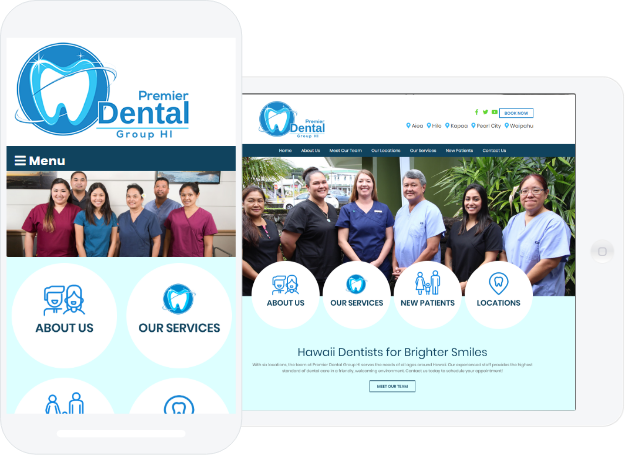Where do most prospective patients find you? Typically, it’s your website.
What’s the first page they visit on your site? Typically, it’s your homepage.
Your dental website homepage is your first impression. It’s the reception room to your practice.
A patient-converting homepage involves a number of components. Ultimately, the goal is to persuade visitors to stay on your site long enough that they schedule an appointment.
Optimising For Google With Dental SEO
There’s no single strategy for crafting the perfect dental website homepage. First, it should be optimised for Google – which, by the way, is the number-one source of new patients. Optimising your homepage for Google requires search engine optimisation (SEO).
 Now, dental SEO is a balancing act. Stuffing a bunch of keywords on your homepage won’t get you very far. In fact, it will do more harm than good. Over-optimised content is a turn-off not only to website visitors, it can be seen as manipulative by Google.
Now, dental SEO is a balancing act. Stuffing a bunch of keywords on your homepage won’t get you very far. In fact, it will do more harm than good. Over-optimised content is a turn-off not only to website visitors, it can be seen as manipulative by Google.
Rather, keywords should be sprinkled naturally throughout your content.
If you’re located in Everton Park, it would be great to rank on the first page for the keyword, “Everton Park dentist.” Writing content using old-school SEO tactics, may look something like this:
Everton Park Family Dental is the best Everton Park dentist to fit your needs. Our Everton Park dental services are the best Everton Park dentist services in the area.
While the target keyword (“Everton Park dentist”) is included, the content reads awkwardly. It is confusing and flagrantly designed to trick Google’s algorithm.
Using the same target keyword, here’s an example of homepage content that is reasonably optimised:
Everton Park dentist John Smith brings state-of-the-art dental care to the Everton Park area. Providing a modern approach to oral care, Everton Park Family Dental offers root canal extractions, TMJ therapy, and cosmetic dentistry services.
Balancing Your Dental Homepage Content
There is much debate about how much content you should have on your homepage. One homepage might contain 1,000 words. Another might contain only 100 words.
Among the thousands of websites we have analysed, we’ve found that the right balance of homepage content is about 300 words.
Balancing your content relies on three questions:
- Are prospective patients aware of what you offer?
- Have you made it clear that you are the best, and only, solution?
- How are you calling visitors to action?
Here’s how each of these questions should be answered:
- Feature your services so that visitors know immediately what you offer
- With compelling content, tell visitors why you are the best oral health solution
- Include clear call-to-action messages that nurture visitors from page to page
Define Your Audience
It’s tempting to target anyone and everyone who is need of dental care (which is, indeed, everyone). But here’s the reality: It’s impossible to serve every type of patient perfectly.
 Refine your audience by asking yourself a few questions:
Refine your audience by asking yourself a few questions:
- What are my bread-and-butter services (i.e. cosmetic dentistry, paediatric dentistry, etc.)?
- What demographic do I typically serve (i.e. age, income, etc.)?
- How far will patients commute (i.e. within 20 minutes of my office)?
The majority of your website visitors are likely female, as women typically control the healthcare budget. This is particularly true in suburban areas.
In this case, your homepage should have a slight feminine bias. The right colours, shapes, imagery, etc. – all of these design elements should have your audience in mind.
All in all, your homepage should cater to your ideal tribe of patients.
When reading a company’s homepage, 86 percent of visitors want to see information about that company’s products or services.
Make an Emotional Connection
Before landing on your website, most visitors have already visited thousands of other websites. In fact, the average user visits 1,000 different websites each year.
In other words, people know what they think about a website the moment they land on it. In a split second, their subconscious has decided, “Yes (or no), I am (or am not) interested in learning more about this business.”
What does this mean? You must create an emotional connection – immediately.
“Wowing” visitors on your homepage is what gets them to learn more about your practice. In making this emotional connection, you encourage them to learn about you and your services.
Here are a few ways to solidify this connection:
- Show authenticity by writing unique content
- Share something personal (why did you get into the dental field?)
- Avoid industry jargon and tell visitors why you can be trusted
When it comes to content, one of the most important factors to keep in mind is that your website isn’t for you. It’s for prospective patients looking for a dentist in your area.
Your content should be written for patients, not for a dental professional.
Why Should a Prospective Patient Choose You?
38 percent of people will leave a website if the content and/or layout is unappealing.
 Using something called “heat mapping” software, we’ve analysed thousands of websites to see how people engage on a site’s homepage. This has provided us with insight into which elements best appeal to the typical dental patient.
Using something called “heat mapping” software, we’ve analysed thousands of websites to see how people engage on a site’s homepage. This has provided us with insight into which elements best appeal to the typical dental patient.
There are several design elements that help you connect emotionally with a prospective patient. Ultimately, your dental website homepage should tell visitors why they should choose you over the potentially dozens of other dentists in their area.
Beautiful photos help space out your content. Professional, custom photography personalises the visitor experience, showing people that you are, indeed, human.
Finally, it’s important to make it clear what visitors should do next. Call-to-action buttons and graphics should be strategically placed throughout your homepage. This can include things such as photos that direct visitors to your “Meet the Doctor” page, graphics that link to your services page, and buttons that encourage visitors to schedule an appointment.


